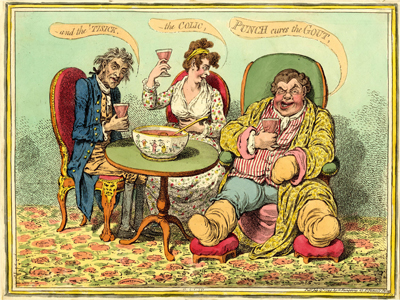Punch Cures the Gout, the Colic, and the 'Tisick
The title and concept of this print derive from a version of a popular drinking song, "Landlord, Fill a Flowing Bowl" which in turn is based on a passage from John Fletcher's The Bloody Brother, or Rollo, Duke of Normandy Act II, Scene 2.
Come, landlord, fill a flowing bowl, until it does run over;
To-night we all will merry be, to-morrow we'll get sober.
He that drinks strong beer, and goes to bed mellow,
Lives as he ought to live, and dies a hearty fellow.
Punch cures the gout, the colic and the tisic,
And is to all men the very best of physic. . . .

© Trustees of the British Museum
Like most drinking songs, this one and its variant, "Three Jolly Coachmen" were clearly intended to be sung by men. One of the other verses was this:
He that courts a pretty girl, and courts her for his pleasure,
Is a fool to marry her without a store of treasure.
But because his is a visual representation of the song, Gillray uses two men and a woman who best illustrate the maladies mentioned in the verse. Gout most often attacked overweight men who overindulged in sweet alcoholic drinks like port (and punch). It resulted in red, swollen joints that were often swathed in bandages or flannel to prevent painful shocks and to induce perspiration which was thought to "expel gouty matter."
Apart from babies, colic was most often associated with women. That was because one of the principal causes of colic is lead poisoning, and many of the most popular cosmetics of the 18th century were full of lead. As is suggested by the woman with her hand to her stomach, colic is characterized by intense intestinal pain, and constipation.
The ancient Greeks called tuberculosis "phthisis" and "Tisick" is likely a variant upon it. Then, as now, it was characterized by what we see in the third gentlemen in Gillray's print—a general wasting away of the body.
All three of these people are sick and suffering pain; but they are choosing to drive the thought away by turning to that "very best of physick"—a "flowing bowl" of punch. There is a certain bravado in ignoring the pain and asserting this temporary cure
But if we can assume that Gillray's audience is likely to have known the song, they would know that the bravado is foolish; and their foolishness is satirized by the larger implied perspective of death awaiting.
Now let us dance and sing, and drive away all sorrow,
For perhaps we may not meet again to-morrow.
Gillray may have realized that this was rather grim satire, even for him. So he does something extraordinary—he undercuts the "sanity" of the print perspective itself by presenting the title backwards, from right to left instead of left to right. The print perspective can then seen as drunken itself (and therefore invalid). Or if this is too much of a stretch, it may be that Gillray simply wanted to inject a humorous "mistake" into an otherwise grim satire.
Sources and Reading
- Commentary from the British Museum on Punch Cures the Gout, the Colic, and the 'Tisick.
- The Jolly Fellow
- "Gout" Wikipedia
- "Painter's Colic," Merriam Webster
- "phthisic," Wikipedia
- "English Caricature: Excess and the Over-Consumption of Food & Alcohol," 'Very Ill!' The Many Faces of Medical Caricature in Nineteenth-Century England & France
- Roy Porter, "Gout: Framing and Fantasizing Disease" Bulletin of the History of Medicine Vol. 68, No. 1 (Spring 1994), pp. 1-28.
- Thomas Wright and R.H. Evans, Historical and Descriptive Account of the Caricatures of James Gillray #453.
- Thomas Wright and Joseph Grego, The Works of James Gillray, the Caricaturist; With the History of His Life and Times, p. 265.
Comments & Corrections
NOTE: Comments and/or corrections are always appreciated. To make that easier, I have included a form below that you can use. I promise never to share any of the info provided without your express permission.